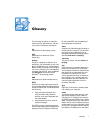
Glossary 5
RAID 0
RAID 0 is commonly called
striping
. This
was not originally defined as a RAID level
but has since come into popular use. In
this array configuration, data is written
sequentially across the available disks and
no redundancy is provided. RAID 0 config-
urations provide very high performance
but relatively low reliability. RAID 0 is the
best choice when DSA controller cards
are duplexed. See also striping.
RAID 1
RAID 1 is commonly called
mirroring
.
RAID 1 also uses striping, so RAID 1 may
be regarded as the mirroring of RAID 0
configurations. RAID 1 is the best choice
in high-availability applications that require
high performance or relatively low data ca-
pacity. See also mirroring, RAID 10,
striping.
RAID 4
RAID 4 is commonly called
guarding
. It
uses data striping, like RAID 0, but adds a
single, dedicated parity drive. The parity
data stored on this drive can be used to
recover data lost from a single failed drive.
RAID 4 configurations write data slowly
because parity data has to be generated
and written to the parity drive, and the
generation of the parity data frequently re-
quires reading data from multiple physical
drives. See also guarding and striping.
RAID 5
RAID 5, like RAID 4, is commonly called
guarding
. RAID 5 is identical to RAID 4,
except that the parity data is distributed
evenly across all physical drives instead
of a parity drive. In configurations using a
large number of physical drives in which
a large number of simultaneous small
write operations are being performed,
RAID 5 offers potentially higher perfor-
mance than RAID 4. RAID 4 and RAID 5
configurations are appropriate in high-
availability applications where
performance is less critical or where high
data capacity is required. See also
guarding.
RAID 10
RAID 10 is a
mirroring
technique in which
data is duplicated across two identical
RAID 0 arrays or hard-disk drives. All data
on a physical drive in one array is duplicat-
ed, or
mirrored
, on a drive in the second
array. Mirroring offers complete redun-
dancy of data for greater data security.
See also mirroring, RAID 1, and striping.
rpm
Acronym for revolutions per minute.
SCSI
Acronym for small computer system in-
terface. An I/O bus interface with faster
data transmission rates than standard
ports. You can connect up to seven devic-
es (15 for some newer SCSI types) to one
SCSI interface.
SDS
Abbreviation for Scalable Disk System.
sector
The fundamental unit of data access for a
hard-disk drive. For PC-compatible sys-
tems, a sector is usually 512 bytes. See
also block and block size.
SMB
Acronym for system management bus.
SMM
Abbreviation for server monitor module.
An ISA expansion card that provides a mo-
dem interface for out-of-band monitoring
and control of a server.
SMP
Abbreviation for Symmetric
Multiprocessing.
SMS
Abbreviation for Systems Management
Server.
SNMP
Abbreviation for Simple Network Man-
agement Protocol.
SQL
Abbreviation for Structured Query
Language.
striping
In composite drivers with two or
more physical drives, the drive array


















